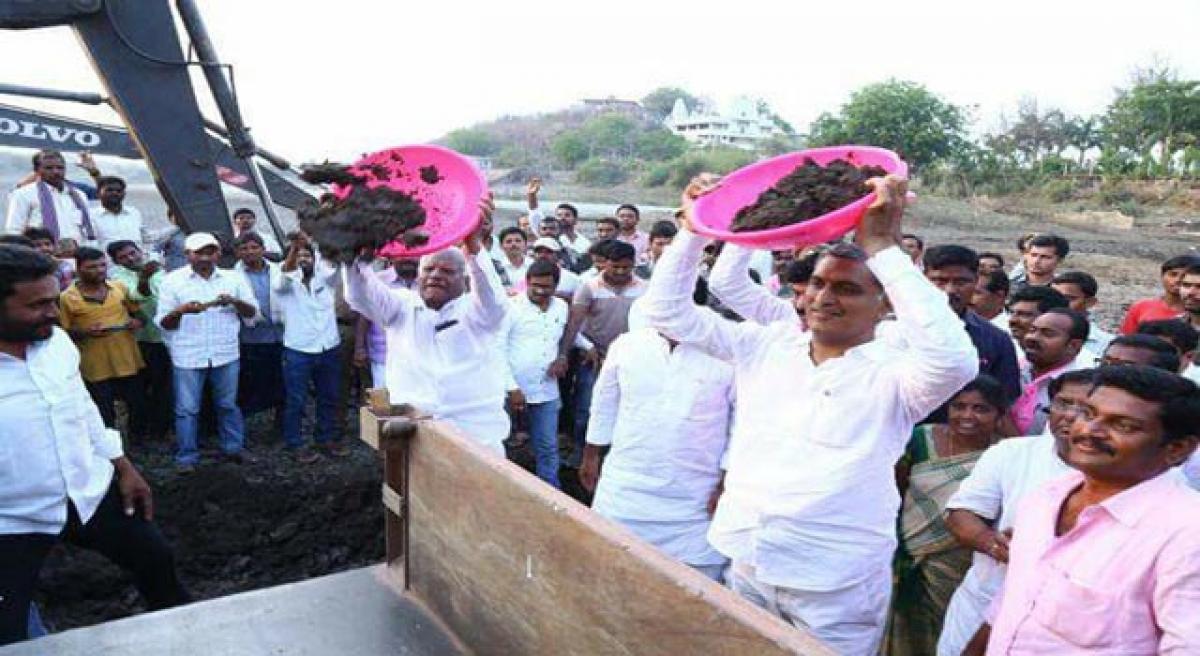Live
- Former Speaker Tammineni’s clout on the wane
- Attack on media: Take action against Mohan Babu, demand journalists
- More sports equipment promised at Central Park
- Mohan Babu’s attack on journalists inhumane act
- West Quay-6 of VPA to get revamped
- Rajaiah demands govt to introduce SC categorisation Bill in Assembly
- Make all arrangements for smooth conduct of Group-2 exams
- CP congratulates chess champs
- Stage set for children’s science exhibition
- ‘Generation Green’ initiative to drive e-waste awareness
Just In
Depletion in tank levels can’t be imputed to Mission Kakatiya


Avala Butchi Reddy in his letter has expressed that implementation of Mission Kakatiya is the reason behind the falling water levels in fish tanks.
Avala Butchi Reddy in his letter has expressed that implementation of Mission Kakatiya is the reason behind the falling water levels in fish tanks. He opines that tank silt was removed using JCBs which exposed the porous layer of tank bed and allowed water to drain rapidly. That is why earlier rulers banned farmers to take silt from the tank beds.
This is hypothetical and does not reflect the ground reality. While formulating the guidelines for the implementation of Mission Kakatiya, this aspect was also elaborately discussed and framed guidelines not to disturb the natural layer of tank bed while desilting the tank. The desilting process was carried out scientifically only. It was done up to restricted depths keeping in mind that indiscriminately desilting a tank is going to be counter-productive.
We have taken utmost care leaving distance equal to 10 times height of bund from the toe of the bund. This distance will work like a clay blanket which will take care of percolation of water. We did not come across any such case where percolation is rapid in desilted tanks and slow in tanks which are not desilted.
The rapid/slow percolation of water depends on the soil nature in that particular area. In some areas to save and store the water in the tanks, we are going for positive cut of wall with impervious soils all along the bund on water side. While excavating the deposited silt using heavy machinery, we are only removing deposited silt.
Desiltation below sluice sill level is not allowed and progressive gradient is maintained. Nowhere tampering of bed porous strata is allowed. The quantity of desiltation is quite little when compared with accumulated bed silt. As such, the possibility of seepage of water by silt application is remote.
Increase in the intensity of irrigation under tanks in this Rabi season may be one of the reasons for fast depletion of water levels in the tanks apart from conditions of sub-surface layers. Normally, 2 to 2.5 lakh acres would be irrigated under tanks in Rabi season. As per our records, 7.5 lakh acres are irrigated under tanks in this Rabi season which is an all-time record.
Ground Water Department studies revealed that at an average 10 m enhancement is observed in the state after implementation of Mission Kakatiya which in turn enhanced cultivation under bore wells beyond the command area of a tank. The more ground water drawls, the more would be sub surface percolation. This could be one reason for rapid depletion of water levels in the tanks. Hence, rapid water level depletion in tanks cannot be attributed to Mission Kakatiya.
In fact, desilting is not a new. It is an ancient wisdom of our farmers. Till 1975 farmers used to carry mineral rich tank silt by bullock carts and apply it in their farm lands. After the advent of green revolution and introduction of hybrid seeds, farmers had to invariably shift to chemical fertilisers and pesticides. Government policies were also in favour of chemical fertilisers and made farmers keep away from their ancient practice of silt application.
Cases were booked and vehicles were seized who resort to carry tank silt. That is how desilting of tanks halted and tanks accumulated heavy silt over the years. The rulers of combined Andhra Pradesh did not want water to be captured in thousands of water bodies which were built by Kakatiyas, Kutubshahis, Asafzahis and local lords and simply flow down to the rivers and ultimately to the sea.
They allowed these tanks to face natural extinction by way of siltation, breaches, leakages, encroachments, jungle growth etc. Life line of Telangana was cut and Telangana was turned into graveyard of farmers and land migrations. Restoration of these dilapidated tanks to their original standards was an aspiration of Telangana people during agitation for statehood for Telangana.
After formation of Telangana, the State government has taken up this flagship programme of Mission Kakatiya for comprehensive restoration of tanks as a people’s participatory programme instead of mere government programme. We would like to recall that Dr M S Swaminathan, Father of Green Revolution in India, has expressed jubilation that farmers are encouraged to carry tank silt in Telangana under Mission Kakatiya thereby turning them to adopt their ancient practice.
He suggested that all the States should encourage farmers to apply mineral rich tank silt in their farm lands. Mission Kakatiya is receiving appreciations from all over the world. It is being discussed in many international seminars/forums. The programme has become a model for other States. Till now engineers and policy makers from Maharashtra, Uttar Pradesh, Madhya Pradesh, Odisha and Tamil Nadu states have visited Telangana to study the implementation and impacts of Mission Kakatiya.
The Central Water Commission is preparing a policy paper for comprehensive restoration of minor irrigation tanks in the country for which Mission Kakatiya is the source of inspiration. (Sridhar Rao Deshpande is OSD to Irrigation Minister and Bheem Prasad, Executive Engineer, I&CAD Dept, Telangana)
By Sridhar Rao Deshpande & Bheem Prasad

© 2024 Hyderabad Media House Limited/The Hans India. All rights reserved. Powered by hocalwire.com






